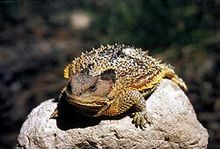Greater short-horned lizard
| Greater short-horned lizard | |
|---|---|
 |
|
| Scientific classification | |
| Kingdom: | Animalia |
| Phylum: | Chordata |
| Subphylum: | Vertebrata |
| Class: | Reptilia |
| Order: | Squamata |
| Suborder: | Iguania |
| Family: | Phrynosomatidae |
| Genus: | Phrynosoma |
| Species: | P. hernandesi |
| Binomial name | |
|
Phrynosoma hernandesi Girard, 1858 |
|
The greater short-horned lizard (Phrynosoma hernandesi), also commonly known as the mountain short-horned lizard, is a species of lizard endemic to western North America. Like other horned lizards, it is often wrongly called a "horned toad" or "horny toad", but it is not a toad at all. It is a reptile, not an amphibian. It is one of seven native species of lizards in Canada.
The specific name, hernandesi, honors Francisco Hernández (1514–1587) a Spanish physician who wrote an early account of a horned lizard, which was published in 1615.
The greater short-horned lizard is often mistaken for its close relative the pygmy short-horned lizard (Phrynosoma douglasii ), which has the same basic body type consisting of small pointed scales around the head and back. Until recent mitochondrial DNA evidence, P. hernandesi was considered to be the same species as P. douglasii. They are now considered distinct species with the pygmy short-horned lizard (P. douglasii ) occupying the northwest portion of the United States and extreme southern British Columbia. When placed together the two are easily distinguished at full size, the pygmy short-horned lizard being much smaller. P. hernandesi is a highly variable species with different geographic populations exhibiting differences in color, pattern and size with some authorities describing five subspecies.
The greater short-horned lizard ranges in size from 2 to 5 inches (5.1 to 12.7 cm) in snout to vent length (SVL) and is a flat-bodied, squat lizard with short spines crowning the head. They have a snub-nosed profile and short legs. The trunk is fringed by one row of pointed scales, while the belly scales are smooth. The color is gray, yellowish, or reddish-brown, and there are two rows of large dark spots on the back. When threatened or aggressive, their colors become more intense.
Females grow to larger sizes than males: females average about 7 cm (about 2.75 inches) from snout to vent, with a maximum total length of about 15 cm (about 6 inches), and weigh about 18 g; whereas males have an SVL of only about 5 cm (about 2 inches), and weigh on the average about 10 g.
...
Wikipedia

